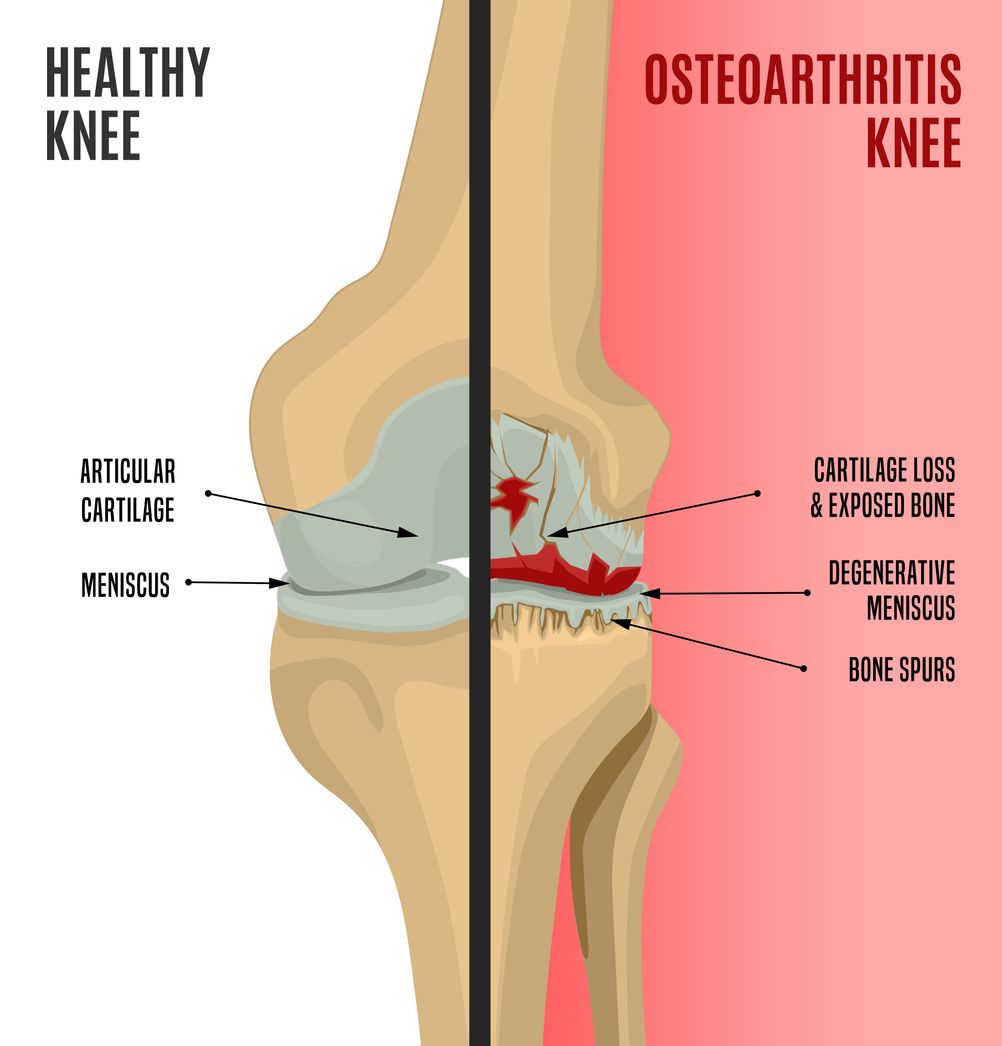Regenerative Strategies to Prevent and Treat Osteoarthritis (Part 2 of 2)
By Dr. Ayo Bankole
Osteoarthritis (OA) is a painful degenerative and inflammatory condition of mostly, but not exclusive to large, weight bearing joints, namely the hips and knees. OA progression is highly associated with a reduced quality of life. It is also the most common cause of disability in the United States. To date, there is no cure per se for osteoarthritis. Since this crippling and slowly progressive disease lacks a known cure, the best hope for improved outcome should include efforts aimed at prevention. Therapy should start early on and should involve lifestyle methods, based on a regenerative paradigm. A regenerative paradigm entails therapies with the potential to restore, repair and regenerate function and structure to cells and tissue. Here in part two, I discuss the role of a Mediterranean diet and maintenance of a healthy body weight in preventing and treating osteoarthritis. In part one I described the benefits and evidence supporting glycosaminoglycans and fruit polyphenols in the prevention and treatment of osteoarthritis.
Exercise and Healthy Weight Maintenance
Being overweight and having type 2 Diabetes are both long-established risks for OA. Conversely, exercise and weight loss have been independently shown to decrease the risk of arthritis but also to decrease pain and improve function. Weight loss has been shown to improve function and reduce arthritis pain of larger weight bearing joints such as the hips and knees in those who exercise regularly relative to less active adults. According to a 2016 study (6), not only is pain and function improved in middle-aged women who exercise and achieve moderate (5% of body weight) weight loss, but they enjoyed a “significant reduced risk of arthritis” as confirmed by radiographic images. Physical activity has also been shown to reduce arthritis associated medical visits and costs after twelve months. Studies have even shown that the benefits of exercise in those with osteoarthritis can be maintained for up to six months after exercise has stopped (7). Both exercise and weight loss are shown to decrease inflammatory signals associated with the inflammation and deterioration of arthritis, to reduce joint pain, to improve physical function and to minimize obesity associated arthritis risks to joints (8).
Mediterranean Diet
Diet and nutrition have long been recognized to be related to arthritis. The Mediterranean diet (MD) is supported by nearly ten studies, three or more of which are systematic reviews, to benefit arthritis sufferers. Notwithstanding some regional variances, common traits of the MD include high representation of vegetables, fruits, legumes, nuts, seeds and cereals; fish and seafood; and moderate consumption of poultry, eggs, and dairy products. The moderate intake of red wine and the reliance on olive oil as the main source of dietary fats are features as well. One small study of 100 participants in England showed improved knee flexion and hip rotation, decrease levels of the inflammatory signal IL-1-alpha and decreases in a specific cartilage degradation byproduct by eight percent. Even more compelling is a study of the relationship between the MD and cartilage thickness in 800 osteoarthritis sufferers. The investigators determined that “significant improvement” in cartilage thickness was highly correlated with adherence to the MD according to several plains measured by MRI (9). Olives and olive oil are prominent in the MD (10). While hydroxytyrosol, a major flavanol found in olives, has been associated with health benefits including antioxidant, anti-inflammatory and anti-diabetic effects; it is also shown to alleviate arthritis in animal models and humans as part of a Mediterranean diet (11).
Summary
The mechanisms of pain, inflammation, and degradation of articular cartilage, joints, and joint related connective tissue leading finally to osteoarthritis are multifaceted. There is sufficient evidence to show that osteoarthritis and its related pain and dysfunction is best addressed early and that nutritional habits like adopting a Mediterranean diet, proper blood sugar control, exercising regularly and maintaining appropriate body weight can play a key role in treatment and prevention. The above measures along with consuming foods rich in flavonoids, anthocyanins, hydroxytyrosol, and other polyphenols are not only shown to decrease pro-inflammatory mediators like MMP and some interleukins involved in pain and osteoarthritis, but also are shown to improve joint function and pain scores. Finally, glycosaminoglycans like glucosamine and others are the major structural components of connective tissue and are known to increase the production of cartilage forming cells, slow down deterioration and decrease destructive inflammatory mediators. These methods combined represent some components of a regenerative approach to chronic joint pain and osteoarthritis that in absence of injury, hold the potential to reduce the need for prolotherapy.
Dr. Ayo Bankole is a state licensed doctor providing Regenerative Medicine for over a decade. He has advanced training in the technique and is a member of the American Osteopathic Association of Prolotherapy Regenerative Medicine, www.prolotherapycollege.org, and American College for Advancement in Medicine, www.acam.org and the California Association of Naturopathic Doctors, www.calnd.org.
To learn if Prolotherapy is right for you and more about our comprehensive strategies for your health, schedule your free 15-minute Discovery Call or by calling 909-981-9200.
Part 1 References:
1.Castrogiovanni P, Trovato FM, Loreto C. Nutraceutical Supplements in the Management and Prevention of Osteoarthritis.Int J Mol Sci. 2016 Dec 6;17(12). pii: E2042.
2.Eugene J. Kucharz EJ Volodymyr Kovalenko,Sándor Szántó. A review of glucosamine for knee osteoarthritis: why patented crystalline glucosamine sulfate should be differentiated from other glucosamines to maximize clinical outcomes 2016 Feb, pp 997-1004
3.Henrotin Y, Marty M, Mobasheri A. What is the current status of chondroitin sulfate and glucosamine for the treatment of knee osteoarthritis? 2014 Dec;79(4):487.

